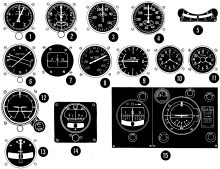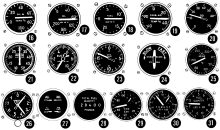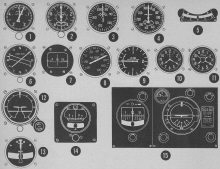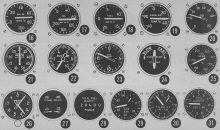|
Sure, you can go online and
find hundreds or maybe thousands of instances of real-life aircraft instrument images
for your model airplane or helicopter, then scale them to the right size and do
a high definition color printout for gluing onto the panel of your latest pride
and joy. However, prior to just a couple decades ago, the task was more difficult.
You could fairly easily find instrument images in magazines and books and then make
copies on a printer or copying machine; some even had a scaling function allowing
you to change the size to fit your need. That was so for about the last four to
five decades, and often gaining access to a printer. Before that, it was necessary
to either be lucky enough to find printed images of the correct size, or buy a set
of printed instruments from a company that sold instruments sets of various scales
(1/16th, 1/8th, 1/10th, 3/16ths, 1/4, etc.). Those were almost always in black and
white. A large set of instruments (31 total) was printed in the 1960 Annual issue
of Air Trails magazine for the benefit of those without convenient access
to such things. All are presented here in the full resolution of my scanner. A "clean"
set is presented along with a set of the raw scans, so you can process them as desired.
These scale aircraft instruments might look more authentic on your vintage model.
See also Cockpit
Details for the Scale Model, from the same issue.
Instruments for the Scale Model


"Clean" scan version of aircraft instruments (click for full-size).
By James M. Triggs
Probably one of the most fascinating yet most difficult details to model in the
miniature scale airplane is an instrument panel. Presented here is a selection of
the standard and most common instruments found in modern propeller-driven airplanes.
Also included are several engine instruments designed specifically for the modern
jet engine. The instruments are shown at exactly 4 inch scale (4 inches equal 1
foot). While this is a considerably larger scale than most modelers will wish to
use, the instrument faces are shown this size for clarity and sharpness of reproduction.
It is suggested that the model builder wishing to use these instrument faces in
making up a panel to a smaller scale have the page photocopied or photostated to
the correct size for his model. For a 2" scale model, have the page copied and reduced
1:2, or 50%; for a 1" scale model, reduce 3/4, or 75%, etc.
A brief discussion of the. function of each of the instruments will help the
model builder in planning a panel accurately and increase his understanding of the
purpose of the various instruments in various types of aircraft.


"Raw" scan version of aircraft instruments.
Flight Instruments. These are the basic instruments which enable
the pilot to fly the airplane under all conditions and are concerned with the actual
flight and physical attitude of the airplane.
1. Standard Altimeter - Measures actual height above sea level by measuring atmospheric
pressure. A knob permits the pilot to set the altimeter at zero to correspond with
the altitude of the airport from which or into which he is flying. This is the primary
instrument used to maintain level flight. The altimeter is required by C.A.R. (Civil
Air Regulations) for all aircraft.
2. Sensitive Altimeter - Similar to the standard altimeter but this instrument
is far more accurate and is provided with a barometric scale setting and temperature
compensation. Specified by law for instrument flight (two are required for all airline
passenger carriers).
3. Standard Airspeed Indicator - This is actually a sensitive differential pressure
gauge which indicates the speed at which the airplane is passing through the air
around it. It is actuated by a pitot-static tube which is mounted outside the airplane
facing into the air stream. Required by C.A.R. for all aircraft.
4. Sensitive Airspeed Indicator - Used primarily where a very close reading in
miles per hour at high speeds is necessary for precision navigation.
5. Ball Bank Indicator - This is simply a liquid-filled glass tube containing
a free rolling steel ball. This instrument indicates skidding or slipping in a turn
and is installed primarily in small lightplanes used for student flight instruction.
6. Direction Indicator, Remote - A remote indicator in which the actual compass
element is placed away from the panel, usually in the rear fuselage. This practice
eliminates the compass deviation caused by metal parts in the panel and near the
engine.
7. Magnetic Compass - This instrument indicates the direction of the air-plane
with respect to the magnetic pole. Since the magnetic compass is affected by metal
objects within the airplane, a deviation card is usually affixed to the panel near
the compass which aids the pilot in translating the indicated compass reading into
an actual magnetic course. The magnetic compass is required by law for all aircraft
operating on cross-country flights and for all airline passenger carriers.
8. Air Thermometer - Indicates the outside air temperature and aids the pilot
in avoiding icing conditions and as a gauge to the amount of temperature compensation
which must be computed to obtain accurate airspeed. Required by C. A. R for all
airline passenger carriers.
9. Rate of Climb Indicator - Pressure sensitive instrument which indicates the
speed at which the airplane is rising or descending. Required by law for instrument
flight.
10. Clock - Standard aviation 8-day clock made to withstand vibration and shock
and very accurate.
11. Clock - Elapsed-time clock with sweep second-hand. This instrument indicates
time elapsed since setting and provides the pilot with the stop-watch function of
the sweep second hand. Specified by C.A.R for instrument flight and airline passenger
carriers.
12. Artificial Horizon - A gyroscopic instrument which indicates accurately the
physical attitude of the airplane, climb, glide, bank, etc. The gyro contained within
the instrument is driven by an outside venturi or by an engine driven suction pump.
13. Turn & Bank Indicator - Also a gyro instrument driven by suction. The
gyro element actuates the turn indicator while correct bank is indicated by the
ball in the tube (like the ball bank indicator). Required by law for instrument
flight and for airline passenger carriers.
14. Directional Gyro - This is a gyroscopic instrument which indicates direction.
The directional gyro (or gyro compass) is non-magnetic and must be set to correspond
with the magnetic compass, however, it is not subject to oscillation, overswing
or lag as is the magnetic compass nor is it affected by surrounding metal objects.
15. Automatic Pilot - Actually a combination of the artificial horizon and gyro
compass whose movements actuate the controls of the airplane to keep it in level
flight and on course. Turns, climbs, and glides can be made using the adjusting
knobs on the face of the panel.
Engine Instruments. The following constitute the most common
and necessary instruments needed by the pilot to insure proper operation of the
airplane powerplant.
16. Oil Temperature Gauge - Measures oil temperature within the engine and provides
the pilot with an indication of proper engine function. Specified by C.A.R for all
airplanes with air-cooled engines.
17. Oil Pressure Gauge - Required by law for all aircraft engines using oil-pressure
systems.
18. Fuel Pressure Gauge - Used on aircraft engines employing pressure fuel systems.
(Most lightplanes have gravity fuel systems).
19. Carburetor Air Thermometer - Indicates the temperature of the fuel-air mixture
at the carburetor and provides a warning of carburetor icing. A similar instrument
is the cooling liquid thermometer which shows the temperature of the liquid engine
coolant. The cooling liquid thermometer is designated by C.A.R for all liquid cooled
engines.
20. Fuel Quantity Gauge - Indicates actual fuel in tanks. Required by law for
all airplanes.
21. Manifold Pressure (Boost) Gauge - Shows the pressure of the fuel-air mixture
as it enters the cylinders. This instrument functions as a warning indicator against
over compression in supercharged engines. Listed by C.A.R for all altitude (supercharged)
engines.
22. Suction Gauge - Provides an indication of proper vacuum or suction pump operation
for gyro instruments. Specified for all airline passenger carriers.
23. Tachometer - This provides the pilot with an accurate reading of engine R.P.M.
and is an indication of proper engine function. Required for all airplanes.
24. Synchroscope - This instrument is used on multi-engine aircraft to synchronize
engines so that they all operate at the same R.P.M.
25. Cylinder Head Temperature Gauge - Provides an accurate indication of proper
engine functioning and a warning against engine overheating.
Miscellaneous Instruments.
26. Accelerometer - Gives an indication of the violence of vertical motions of
an airplane and gives a reading of maximum acceleration reached during a flight
as an aid in determining if the aircraft has been subjected to dangerous stresses.
27. Landing Gear & Flap Position Indicator - This instrument shows the pilot
when gear or flaps are retracted or down. This type instrument has been largely
supplanted by light indicators or other warning devices. Required for all aircraft
with retractable gear.
The remaining are but a very few of the many new and improved instruments used
in modern jet aircraft in addition to those already listed.
28. Fuel Counter.
29. Tailpipe Temperature Gauge.
30. Thrustmeter.
31. Fuel Quantity Gauge.
Posted October 22, 2022
|